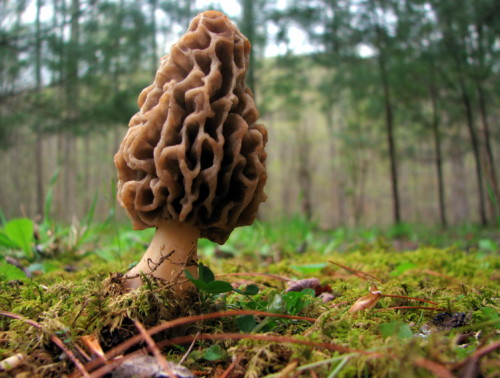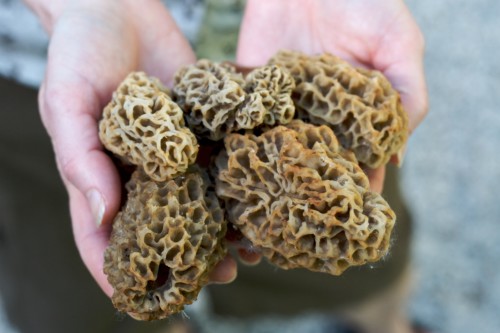Foraging For Morels? Here’s What You Need To Know
Morel mushrooms are some of the most highly-valued culinary mushrooms available in the world today, and for good reason. Their exquisite gourmet flavor, in combination with their relative difficulty to both be grown commercially and found in the wild, makes them one of the most sought-after items that foragers look for. And once a mushroom hunter finds a goldmine, don’t expect them to tell you where it is. Even those “in the know” of what lies in a given area are aware that where morels have appeared the year before, they might not pop up again the next year.
While there’s no way to know for sure where these elusive fungi are sprouting up this spring, this guide will help you to get a head start, and will point you to the right areas when it comes to morel foraging in the Pacific Northwest. If equipped with enough knowledge, patience, and positivity, you just might get lucky.
“Believing is Seeing”
According to David Arora’s classic guide to Western Mushrooms, [easyazon_link identifier=”0898153883″ locale=”US” tag=”gardcoll03-20″]All That The Rain Promises, and More[/easyazon_link], morel hunting is not “a question of visual acuity, but of pattern recognition.” Morel mushrooms are difficult to find, in part, because they are so good at blending into their environment. They grow in patterned formations, however, so once you’re able to find one, a whole host of them just might “appear” before your eyes. From a distance, they look a little bit like a pinecone stuck in the ground, facing upwards. Honeycombed in texture, and brown, black, or yellow in color, they develop slowly, taking several weeks to reach full size, and thus become easier to find as they mature (that is, if someone hasn’t already gotten there first).
When Spring Has Sprung
Morel mushrooms always grow in the spring, usually between March and May, although the season can extend into June in the Pacific Northwest, especially at higher altitudes. When warm spring rains arrive, wildflowers start to bloom, and temperatures rise to the 60’s during the day and 40’s at night, you know it’s the right time to start your hunt.
Learn to Identify Trees
Morels live in and around forested areas, and tend to grow around the bases of ash, elm, aspen, poplar, cottonwood, and apple trees. Look for bigger, older trees that have started to decay, because Morchella love to feast on dying root systems and strips of fallen bark.
Find the Right Area
While morels can be found in a variety of different places, they love the fertile environment of a recent forest fire. Use a Global Incident Map to find recent burn sites, and visit them a year or two after for best results. Morels also like recently logged areas, apple orchards (be sure they haven’t been sprayed with pesticides!), and the sandy, well-drained soil around streams. In early spring, look on south facing slopes for black morels, and on north facing slopes later in the season for lighter, yellow morels. Morchella tend to favor loam soil, which is characterized by a mix of clay and sand.
How to Distinguish a True Morel from a False Morel?
If you have any doubt about a mushroom, don’t eat it. One of the mushrooms most commonly mistaken for a morel is the Verpa bohemica, or early morel, which can be poisonous or cause stomach upset if eaten raw or in large quantities. To distinguish these from true morels, notice where the cap meets the stem. According to Steve Trudell’s Mushrooms of the Pacific Northwest, the Verpa cap is “attached only at the apex of the stipe so that the sides of the cap hang freely, like a lampshade”– unlike the true morel, on which the sides of the cap attach to the stipe at the bottom and do not hang free. Other false morels are highly poisonous raw. These, such as the Gyromitra esculenta, have wrinkly caps that resemble brains, rather than honeycombed pits. Their caps will pull off of their stem much more easily than true morels, and they will be filled with cotton-like matter or tissue inside. True morels, in contrast, are completely hollow inside.
Be an Ethical Forager
Morel mushrooms have declined significantly in the US over the last thirty years. In order to ensure that spores are spread and more mushrooms have the chance to grow next year, use a mesh collection bag instead of plastic or paper, so that the microscopic spores can fall from the mushrooms back to the ground. Additionally, after you’ve picked your morels, crack them open and shake them to allow even more spores to make their way back to the earth.
Always Cook Your Morels
When you find your morels, and have double- and triple-checked that that’s what they definitely are, it’s time to fry ‘em up! [easyazon_link identifier=”0394519922″ locale=”US” tag=”gardcoll03-20″]The Audubon Society Field Guide To North American Mushrooms[/easyazon_link] cautions that “most wild mushrooms are indigestible” and should not be eaten raw or in large quantities. So, soak them first in water to clear out any dirt or bugs that might be lodged inside of them. Then, decide how you’d like to cook them. One of the most popular ways is to simply sauté them in butter, which brings out their nutty, meaty flavor. If you don’t do dairy, you can try roasting them in olive oil, or frying them in coconut oil (or Ghee, for Paleo-friendly folks!)
Happy Hunting!
While we hope you strike gold on your very first mushroom hunt, morel mushrooms can be elusive, and the “de-morelizing” experience of returning from a foraging excursion is indeed part of the process. In order to truly appreciate your first true morel hunting success, it helps to have struggled a bit first. That being said, a positive outlook is everything. You never know when or where these mysterious mycelium will appear. Perhaps the moment you’ve detached from your desperation to find a mushroom, and simply appreciate the beauty of walking through the awakening woods, a group of them might just materialize before your eyes.





































